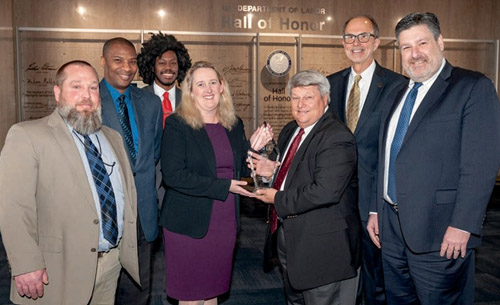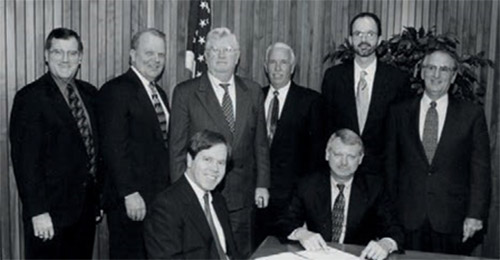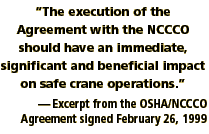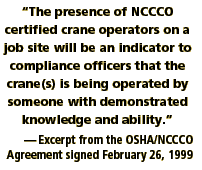April 2019—Twenty years almost to the day that OSHA and NCCCO signed their historic agreement officially recognizing CCO certification as an objective assessment of the knowledge and skills of crane operators, representatives from the two agencies sat down again in the very same room at the Department of Labor in Washington, DC, that the Agreement had been signed in. They reflected on that historic moment and reviewed the events that led up to the publication last November of a final rule that, once and for all, specified the requirements by which crane operators must be qualified.

Pictured in February 2019 receiving a Recognition Award from NCCCO President Kerry Hulse, is Acting Assistant Secretary for Occupational Safety and Health, Loren Sweatt, together with (to her immediate right) Director of Construction Standards and Guidance, Garvin Branch; regulatory analyst, Vernon Preston (behind); and Bryant Seymour, Occupational Safety and Health Specialist. To the right of Hulse are NCCCO CEO Graham Brent and NCCCO Immediate Past President, Thom Sicklesteel.
“It is not overstating the impact of that formal recognition by OSHA to say that the signing of the Agreement between the two organizations in 1999 marked the beginning of a turning point for NCCCO certification and the industry as a whole,” said NCCCO President Kerry Hulse. “While NCCCO was borne directly out of the industry it was designed to serve, the additional credibility that this recognition conferred, together with the third-party accreditation NCCCO had been awarded a year earlier, served as the encouragement needed for many employers to step out from the sidelines and become fully fledged participants in what was, at the time, an innovative and ground-breaking safety initiative,” he said.

Then and Now. The signing ceremony in February 1999 was attended by more than 50 senior representatives of the construction industry including over a dozen of the nation’s preeminent construction organizations and institutions who gathered to witness what the then Director of the Directorate of Construction, Russell Bruce Swanson (second from left), called “an historic moment that many thought would never come.”
Of course, much has been achieved in the two decades since, and the beneficiary, as study after study has shown over the last two decades, has been the construction industry itself and those who work in it, as evidenced by reduced accidents and incidents, fewer injuries and saved lives.
It’s a sentiment echoed by the current Acting Assistant Secretary for Occupational Safety and Health, Loren Sweatt, who paid tribute at the meeting to her team at the Directorate of Construction. “Since the revision in the early 2000s of OSHA’s crane standard by C-DAC (the Cranes and Derricks Advisory Committee) that emerged as a Final Rule in 2010, this team has stayed the course on operator certification as it made its way through various twists and turns until this past November when we finally saw a federal requirement published for crane operators to be certified as part of a comprehensive qualification process,” she said.
“We wanted to make sure we got it 100 percent right,” Sweatt added. “It required a full-court press to get that done and I am very proud of their accomplishment.”
 It was worth the wait, according to NCCCO Immediate Past President Thom Sicklesteel. “As a third-generation crane owner, I really have to commend OSHA for developing what at the end of the day is a highly workable and what I believe will be proven to be an extremely effective qualification process,” he said. “In particular, the evaluation component of the final rule is now clearly defined and eminently practical.”
It was worth the wait, according to NCCCO Immediate Past President Thom Sicklesteel. “As a third-generation crane owner, I really have to commend OSHA for developing what at the end of the day is a highly workable and what I believe will be proven to be an extremely effective qualification process,” he said. “In particular, the evaluation component of the final rule is now clearly defined and eminently practical.”
Now that the rule was published and in effect, the emphasis was on assisting employers with compliance with the new provisions, said Director of Construction Standards and Guidance, Garvin Branch. “As we develop FAQs to respond to questions from the industry, we’ll also be revising the Compliance Guide used by all compliance officers in the field,” he noted.
Reducing Accidents
 The signing ceremony for the joint OSHA/ NCCCO Agreement that was held at the Department of Labor’s headquarters offices in Washington, DC in February 1999 was hosted by then Assistant Secretary for Occupational Safety and Health, Charles Jeffress, who had personal experience of the need for crane operator certification and who declared his appreciation at the ceremony for all that NCCCO had done. “This certification will help us reduce the number of accidents that occur with cranes,” he stated, a prediction which, of course, has proved accurate.
The signing ceremony for the joint OSHA/ NCCCO Agreement that was held at the Department of Labor’s headquarters offices in Washington, DC in February 1999 was hosted by then Assistant Secretary for Occupational Safety and Health, Charles Jeffress, who had personal experience of the need for crane operator certification and who declared his appreciation at the ceremony for all that NCCCO had done. “This certification will help us reduce the number of accidents that occur with cranes,” he stated, a prediction which, of course, has proved accurate.
The ceremony was attended by more than 50 senior representatives of the construction industry including over a dozen of the nation’s preeminent construction organizations and institutions who gathered to witness what the then Director of the Directorate of Construction, Russell Bruce Swanson, called “an historic moment that many thought would never come.”
“It was an extraordinary display of support from the industry for an initiative that was barely three years old and had yet to make a significant impact on crane safety,” said NCCCO CEO Graham Brent. “In many ways, the Agreement was remarkably prescient in its estimation of the effect it would have on the industry, not least in the way it anticipated that certification would become part of the natural progression in crane operators’ careers.”
In light of the significance of the role that OSHA had played in improving the safety record of the construction industry through this action, the NCCCO Board of Directors had wanted to demonstrate its gratitude for the foresight and initiative displayed by OSHA more than two decades ago, said NCCCO CEO Brent. “Too often it seems, regulatory agencies are vilified rather than respected, their successes overwhelmed by negative commentary,” he said. “The anniversary of an event that has made such a contribution to turning the tide on how crane operators in the construction industry are qualified, we feel should not pass without credit being given where it is due.”
Find numerous related resources and extensive historical information in NCCCO’s OSHA Crane Rule Resource Center.
